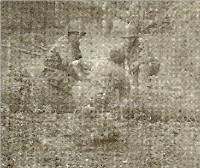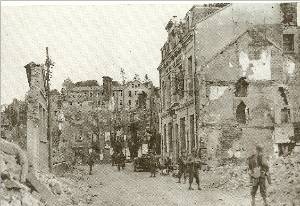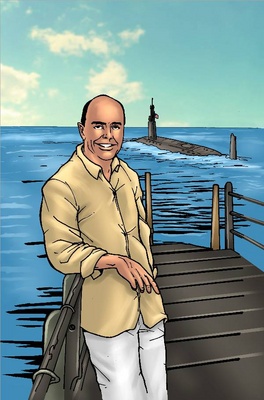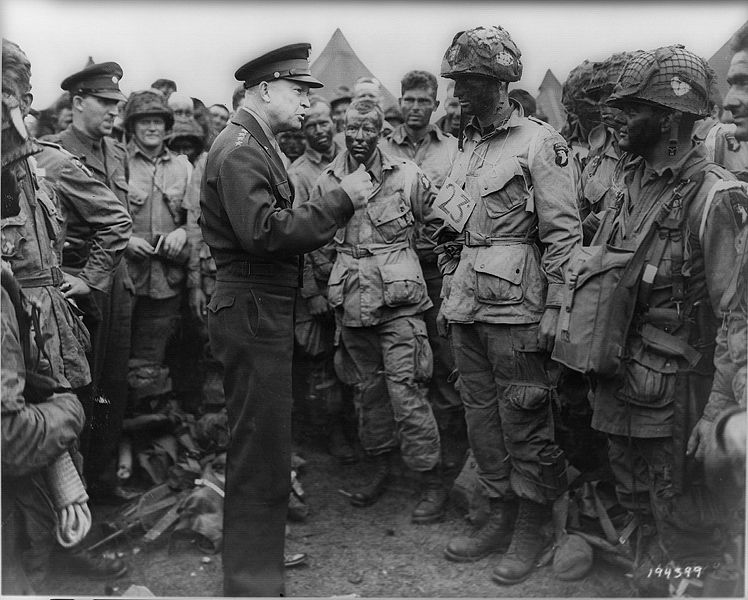by Dennis Blackmore, U. S. Navy Retired
Approximately 100 prisoners were taken this day, and the light machine gun section of Company F had the pleasure of shooting up a German ammunition truck complete with driver, assistant driver, ammunition, and flares. This truck was trying to run through our lines from the rear.
 Unfortunately, however, the “Krauts” on this extremely black night could not lay claim to all the confusion, for in attempting to deliver ammunition, the Battalion A and P leader, Lt George Seaman, delivered himself, Sgt King, his driver, and his vehicle into the hands of the Germans. Sgt King, eight months later, after being liberated by the Russians, rejoined the Battalion at Leipzig. His return route took him through Poland, Russia, the Black and Mediterranean Seas, Marseilles, France, and Western Germany.
Unfortunately, however, the “Krauts” on this extremely black night could not lay claim to all the confusion, for in attempting to deliver ammunition, the Battalion A and P leader, Lt George Seaman, delivered himself, Sgt King, his driver, and his vehicle into the hands of the Germans. Sgt King, eight months later, after being liberated by the Russians, rejoined the Battalion at Leipzig. His return route took him through Poland, Russia, the Black and Mediterranean Seas, Marseilles, France, and Western Germany.
At 0345, 1 August at Les Hogues, France, the Battalion received word to resume the attack at 0630. Again it was believed that the enemy had withdrawn further to the south. On the morning of this seventh day of the continuous attack, the Battalion jumped off making some initial gains but was soon slowed by machine gun and mortar fire.
When the Division scheme of maneuver changed early in the afternoon, putting tank supported elements of the 23rd Infantry directly across our front, this assistance to the attack-weary men of the Battalion was indeed welcome.
 At 1605 the Battalion began moving forward again having Guilberville as its objective. By 2115 this town was mopped up netting 35 prisoners, and action in this sector ceased for the Battalion when the 38th Infantry was pinched out.
At 1605 the Battalion began moving forward again having Guilberville as its objective. By 2115 this town was mopped up netting 35 prisoners, and action in this sector ceased for the Battalion when the 38th Infantry was pinched out.
On 2 August at 1430, Regiment issued a warning order to the Battalion to be prepared to move by motors south of the Vire River. At 0600 on the 3rd of August, the Battalion loaded on vehicles, moved across the Vire River, and detrucked about one and a half miles south of Campeaux; the command post was established at Les Rairies. Our mission was to protect the division left flank against probable armored attacks.
The next day the Battalion Command and Command Group displaced to a forward command post at La Pirelle. At 1000, the 38th Infantry Regiment in Division reserve was ordered to follow by bounds the two assault regiments. Subsequently, the battalion marched 3000 yards and halted the vicinity of L’Aunay to take up defensive positions.
At 1835, it moved just south of Campagnalles to consolidate for the night.
The following morning, the Battalion was ordered to displace to Coulances where, together with the rest of the Regiment, it would remain as a holding force until further orders. The battalion remained static through the 9th of August holding training classes for new men and rebuilding its strength.
On the 10 of August, the battalion made a motor move to Vire with the mission of defending the high ground south thereof. This strategically located city, excellently suited for defense, and tenaciously held by the Germans had cost the 29th US Division a high price in casualties, and now, like St. Lo, was completely destroyed except for a few buildings on its outer fringe.
The battalion’s stay here lasted until the 12th when it moved again. This time to an area one mile east of St Germain de Tallevendi. At 2200, 12 August the Battalion received orders that the Regiment was to pass through the 9th Infantry and attack at 0800, 13 August with the mission of cutting that portion of the Gatheno-Tinchebray Road which lay in its zone. The 2d Battalion’s objective was St Christophe de Chauben, a small town immediately south of the above-mentioned road.
At 0445 the Battalion moved out of its assembly area, marched some 4000 yards and by 0800 having passed through Index, Red was behind its LD ready to jump off. The 3rd Bn, however, requested a 30-minute delay. This being granted the attack started at 0830. Supported by well-placed mortar and artillery fire, the attack made considerable initial progress, however, by midday, the enemy resistance stiffened considerably and our progress throughout the remainder of the afternoon, despite continuous pounding by the mortars and artillery and repeated attack by all three rifle companies was negligible.
And it was not until just prior to dark and after dark that any more appreciable gains were made. By 2118 when orders were issued to button up, the strong points at La Salliere (H-2) and the RJ at (H-3) had been captured and the two leading Companies, E and G, were along the objective road. The day’s prisoner bag was78.
The next day August 14 saw all resistance around the Gathema-Tinchebray Road broken. Co E, against only weak small arms fire, moved into St. Christophe. Co F, supported by a white phosphorous concentration fired by the 81’s took (J-4) with comparative ease and Co G occupied the high ground south of (H-3). The prisoner count for the day was 94.
On August 15 the Battalion marched through Tinchebray onto Hill 248 without opposition. During this march, the glad news of the Invasion of Southern France was received and relayed to the companies over the 300 radio.
Here at Tinchebray, the V Corps was pinched out by the British moving in from the left and the American 29th Division closing in or the right. The 2d Battalion gave up its positions on Hill 248 to a British Battalion and displaced rearwards to an assembly area southeast of Tinchebray where a warning order for a long motor move was received with much curiosity and speculation.
T his was the end of the Normandy hedgerow fighting for the Battalion. It had done a splendid job at Trevieres, its action on Hill 192 had been one of the most decisive in the beach-head battles; its seven days of continuous attack and pursuit through St. Jeanne des Baissants waged against a fanatical and desperate enemy had shown its ability to take anything and keep slugging, and the drive to Tinchebray was apart of the Falaise Pocket operation. One Campaign Star had been won the hard way; the opportunity to win the next was not long in coming.
his was the end of the Normandy hedgerow fighting for the Battalion. It had done a splendid job at Trevieres, its action on Hill 192 had been one of the most decisive in the beach-head battles; its seven days of continuous attack and pursuit through St. Jeanne des Baissants waged against a fanatical and desperate enemy had shown its ability to take anything and keep slugging, and the drive to Tinchebray was apart of the Falaise Pocket operation. One Campaign Star had been won the hard way; the opportunity to win the next was not long in coming.
© 2008 Dennis Blackmore, U. S. Navy Retired
ATTENTION READERS
We See The World From All Sides and Want YOU To Be Fully InformedIn fact, intentional disinformation is a disgraceful scourge in media today. So to assuage any possible errant incorrect information posted herein, we strongly encourage you to seek corroboration from other non-VT sources before forming an educated opinion.
About VT - Policies & Disclosures - Comment Policy




